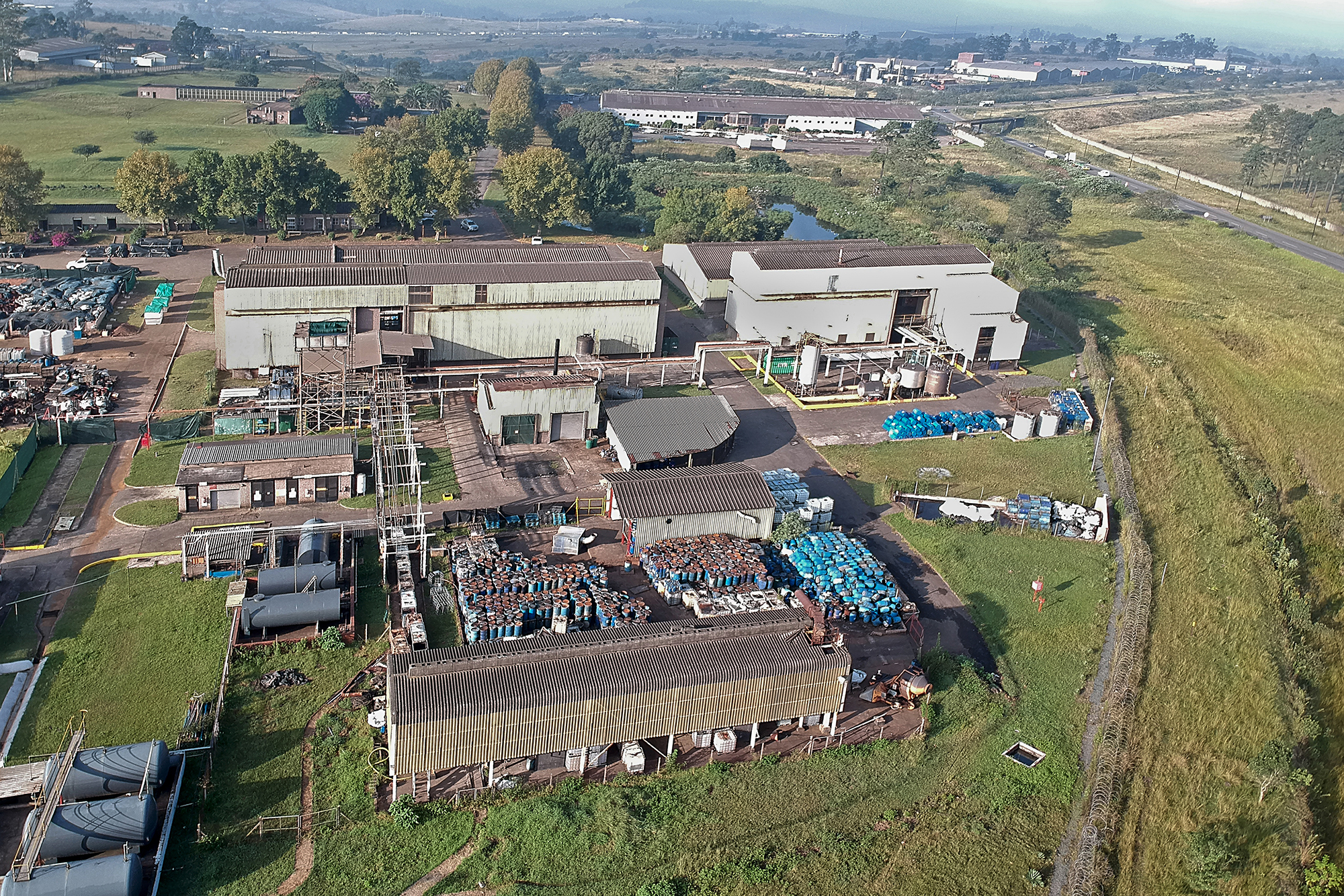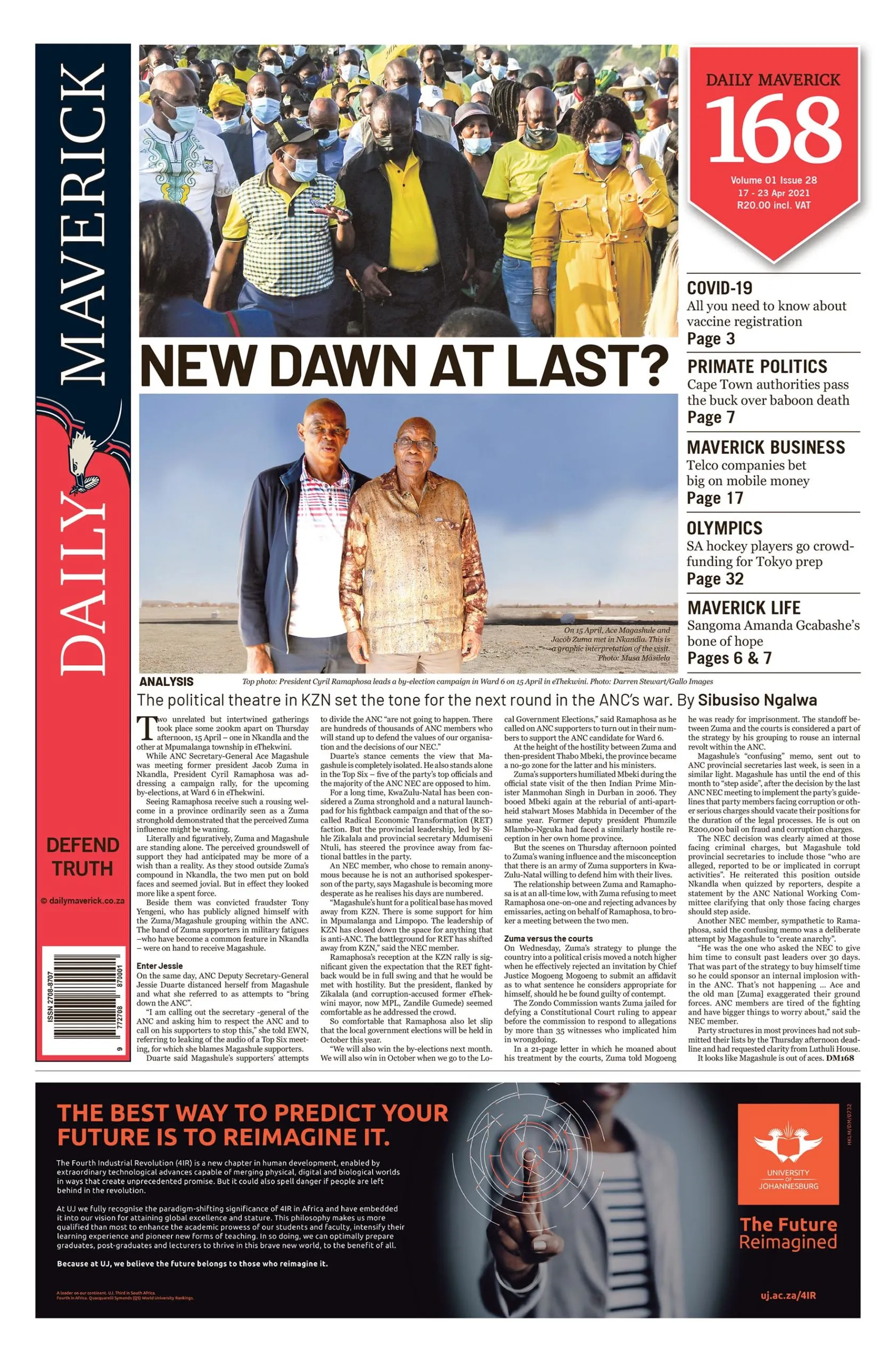DM168 Our Burning Planet
At long last, Thor’s poisonous mercury is getting cleaned up

Workers at a mercury recovery plant near Cato Ridge suffered and died. Despite a commission of inquiry, it has taken three decades to get the huge pile of toxic waste dealt with.
First published in the Daily Maverick 168 weekly newspaper.
It has been nearly 30 years since several emaciated chemical workers died in hospital after being exposed to poisonous mercury fumes and sludges near the small KwaZulu-Natal town of Cato Ridge, at an abandoned factory that holds one of the country’s largest stockpiles of toxic waste.
A British-based multinational group has finally agreed to cough up nearly R174-million to ship several thousands of tonnes of this deadly waste from the old Thor Chemicals factory to Switzerland for treatment.
The waste will be shipped to Batrec Industries near the town of Wimmis, one of the few facilities in the world equipped to deal with this waste.
During the early 1990s at least four Thor Chemicals’ workers died and several more were maimed or disabled from being exposed to powerful toxins that damage the brain and nervous system. Scientists had rung the alarm bells several years earlier after finding grossly deformed tadpoles close to the factory, along with high levels of mercury in the surrounding soil, groundwater and streams.
The mercury “recovery” factory (located in the catchment area of Durban’s largest freshwater source, Inanda Dam) was finally closed by government in 1991. But nearly 20 years later, fishing was banned temporarily at Inanda and surrounding rural communities were also warned not to eat locally grown vegetables because of evidence of mercury contamination in the upper reaches of the dam’s food chain.
At the time, government officials said tests on drinking water at Inanda (about 30km from Thor) showed no level of danger for the general public and there was “no reason to panic”. Nevertheless, a previous study by the SA Medical Research Council found evidence of higher-than-normal mercury levels in several people living around the dam, and 50% of fish samples from the dam were polluted with mercury at levels above the safe eating limits recommended by the World Health Organization.
Although the source of the water contamination remains unclear, the council and other researchers pointed to Thor Chemicals as one of the most likely sources. A separate company, Hebox Textiles, is known to have used mercury to treat SA military tents in the 1980s, with its wastewater routed to the Hammarsdale water treatment works. The nearby Assmang factory (directly opposite Thor) also stored large stockpiles of mining ore and coal waste that may have contained mercury.
Now a new clean-up operation is under way at Cato Ridge after continued pressure on government by the environmental watchdog groups groundWork and Earthlife Africa.
DM168 flew over the site on 13 April with pilot Steve McCurrach, a director of the Bateleurs Flying for the Environment volunteer organisation, which assists researchers, media and conservation groups to undertake aerial reconnaissance inspections at no cost around environmental hot spots.

Thor workers protest. Photo: Chris Albertyn
Several workers in white hazardous chemical suits were seen working next to a large plastic-covered waste pit, while thousands of metal and plastic drums (many of which appeared to be severely rusted or damaged by fire) lay piled up in the open or stashed inside the old factory warehouses.
Last month, in response to written questions in Parliament, Environment Minister Barbara Creecy confirmed that just over 1,000 tonnes of waste had been removed so far in 57 sea-freight containers.
Though her department has declined to comment on the final cost of the operation – and whether SA taxpayers will also have to chip in – DM168 searched English company records and established that the UK-based Tato Holdings group has agreed to set aside nearly R174-million for the clean-up.
Tato, the restructured former parent company of Thor SA, has subsidiary chemical companies spread across the world. It recorded a gross turnover of more than €528-million and pre-tax profits of more than €69-million in 2019.
According to its latest available annual report, the group said it sold Thor to a third party in South Africa several years ago and that this company undertook to remediate the waste.
“The third party, however, did not remediate the waste, resulting in an enquiry from the South African authorities. As a result of this enquiry, the Group took the moral initiative to hire a third party remediator to process the waste in an environmentally acceptable manner using one of the world’s leading treatment companies.”
Tato CEO David Hewitt told DM168 that, following a recent change in the management structure within the Tato Holdings Group, it approached SA-based Guernica Chemicals Limited in 2019 to “establish the current position relating to the issues at their site in Cato Ridge, SA”.
“Following a number of discussions with the management of Guernica and the SA authorities we offered our assistance in collectively working together to resolve this longstanding issue.”
So far, 1,083 tonnes have been repacked and removed from site. The operation (involving a total of 4,700 tonnes) is due for completion in June 2022.

Thor worker Peter Cele. Photo: Horace Potter New Ground
Responding to queries on whether local taxpayers would end up paying part of the clean-up costs, the Department of Forestry, Fisheries and the Environment said that, although Tato would cover the removal expenses, “the Department is however in the process of appointing its own specialist in order to advise whether or not additional rehabilitation is required after the waste has been removed”.
This haggling over costs – which appears to be at the root of the delays – began soon after then-president Nelson Mandela appointed a commission of inquiry to resolve the Thor saga.
Shortly after the Cato Ridge factory was closed, the Thor group also moved swiftly to restructure itself via a demerger operation that appeared to distance the company from direct liability for the waste legacy.
During a 1997 inquiry, commission chair Dennis Davis tried to untangle the complex history surrounding the mercury waste build-up at Cato Ridge and also made recommendations on how to clean up the mess.
He reported that Thor had entered into contracts with several customers to receive mercury-based waste from several chemical companies, including an AECI facility in Sasolburg, Borden Chemicals, Calgon Carbon Corporation and American Cyanamid (United States), Thor (United Kingdom) and other companies in Europe, South America, the Middle East and Indonesia.
Davis concluded that “it must have been clear to any reasonable person … [that] matters had got out of control” and that imported waste could not be treated safely at Thor.
“At this point, probably in the late 1980s, Thor should have both refused to accept further waste and initiated fresh but urgent steps to solve this growing problem,” he said.
But SA government regulators did not come out smelling good either, having failed to hold Thor to account. In fact, said Davis, Thor and the government had “grossly mishandled” the issue.

Thor factory Photo: Steve McCurrach Bateleurs Flying fort the Environment
Former Environment Minister Gert Kotze appeared to have been poorly advised by his officials and had it not been for the tenacity of local environmental groups, the waste crisis would have taken far longer to surface publicly.
These vigilant non-governmental groups had played a crucial role in exposing the scandal, but this was not a substitute for state vigilance and regulation, and government should therefore bear part of the clean-up costs, Davis suggested.
In the local courts, Thor escaped with a slap on the wrist. Three senior managers were taken to court and charged with culpable homicide, but these were later dropped and the company pleaded guilty to a number of safety violations, and ended up paying a R13,500 fine.
Families of some of the dead workers – including Peter Cele, Engelbert Ngcobo, Frank Shange and Felix Mhlanga – and scores of other workers like Petrus Mkhize (who had his left foot amputated after it turned black and went numb) – had to turn to the English courts for compensation.
Although Thor did not admit liability for the deaths and illnesses, the company later paid out several million pounds to several families and workers who pursued compensation in the English High Court.
Behind the scenes, there have also been two suspicious fires that destroyed part of the Thor waste stockpile.
The first fire was at the A-Thermal Retort Technologies (formerly Thermopower) plant in Olifantsfontein, north of Johannesburg, which burnt to the ground on 12 September 2013. Destroyed in the blaze was an unspecified quantity of mercury waste from Thor.
More recently, just after midnight on 24 August 2019, another fire broke out at Cato Ridge, incinerating another chunk of the waste. The SA Police Service opened an arson investigation shortly afterwards, but the results have yet to be published.
Leading environmental activist Bobby Peek issued a blistering statement after the latest Thor fire, charging that: “This crisis is because of a failure of our democratic governance. Like many other environmental hotspots in South Africa, be they the coal mining areas, the south Durban area, and many other industrial toxic dump sites across the country, the government needs to act in a manner that deals with these challenges as an environmental, community health and worker justice issue.
“[Minister Barbara] Creecy has an opportunity to not go down in history as among those that failed society. We have to learn from this governance failure to inform future environmental justice governance as it is prescribed in the Constitution.”

Thor factory Photo: Steve McCurrach Bateleurs Flying fort the Environment
His colleague Rico Euripidou, a groundWork environmental toxicologist, has welcomed the news that a clean-up is finally underway, but he remained sceptical until it was completed.
“This long delay fits into a broader story around the lack of planning and general mismanagement of hazardous waste in South Africa (the Minister promised a hazardous waste plan for SA years ago) – from mining waste which makes up over 70% of hazardous waste to oil refinery waste etc.
“Some researchers who have investigated this case state that the company never intended to recycle the waste in the first place and was instead merely stockpiling it. Many of the barrels were improperly stored and many were leaking by the time the government revisited the site in the early 2000s. Even when it became clear that Thor was failing to treat and dispose of the waste, the company continued with its importations.”
Euripidou said it was also imperative to monitor the further migration of mercury from the waste site on a long-term basis. DM168
Tony Carnie is a Durban-based environmental journalist who has followed the Thor toxic waste saga for 30 years.
This story first appeared in our weekly Daily Maverick 168 newspaper which is available for free to Pick n Pay Smart Shoppers at these Pick n Pay stores.





















 Become an Insider
Become an Insider
Big business getting away with murder, again!